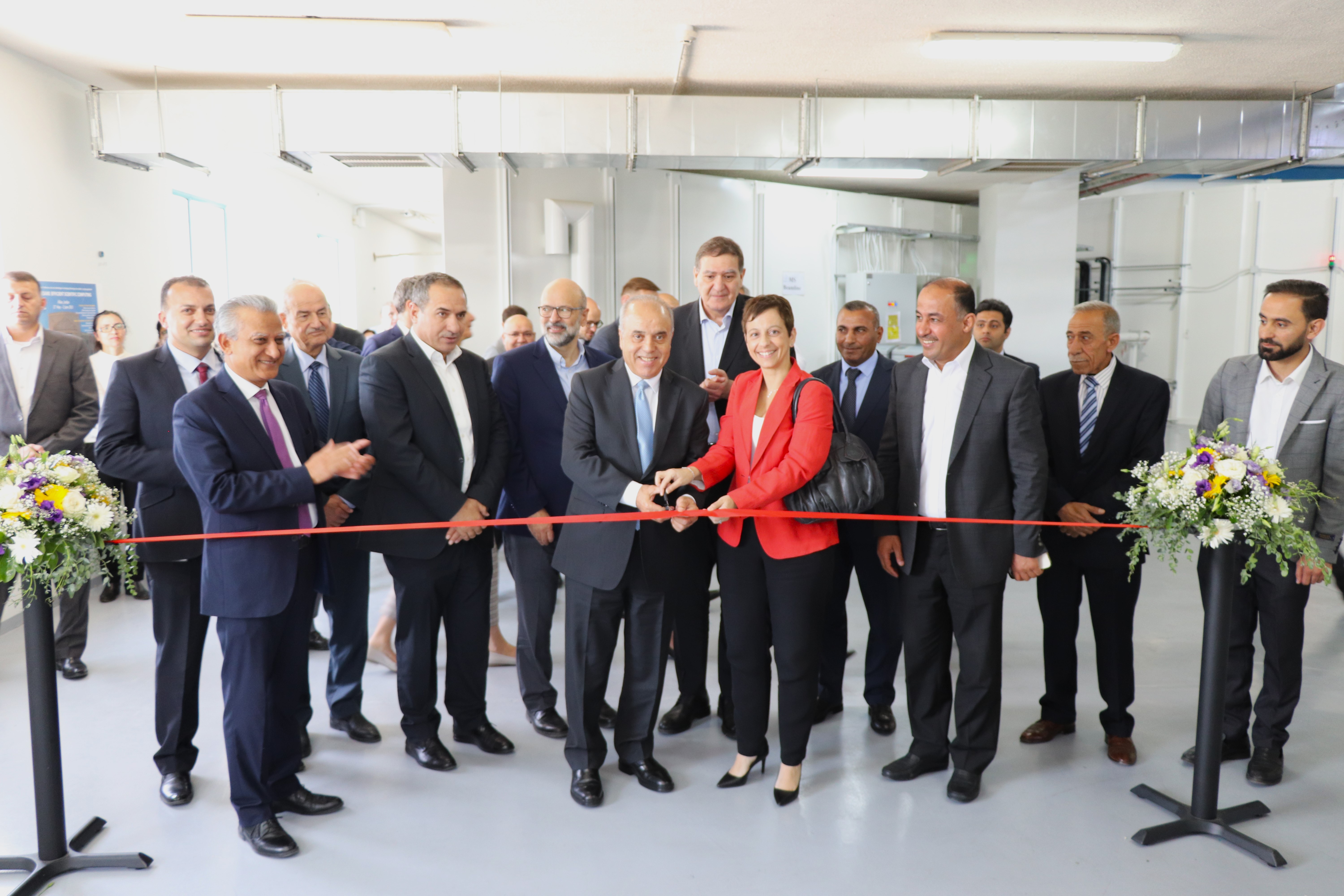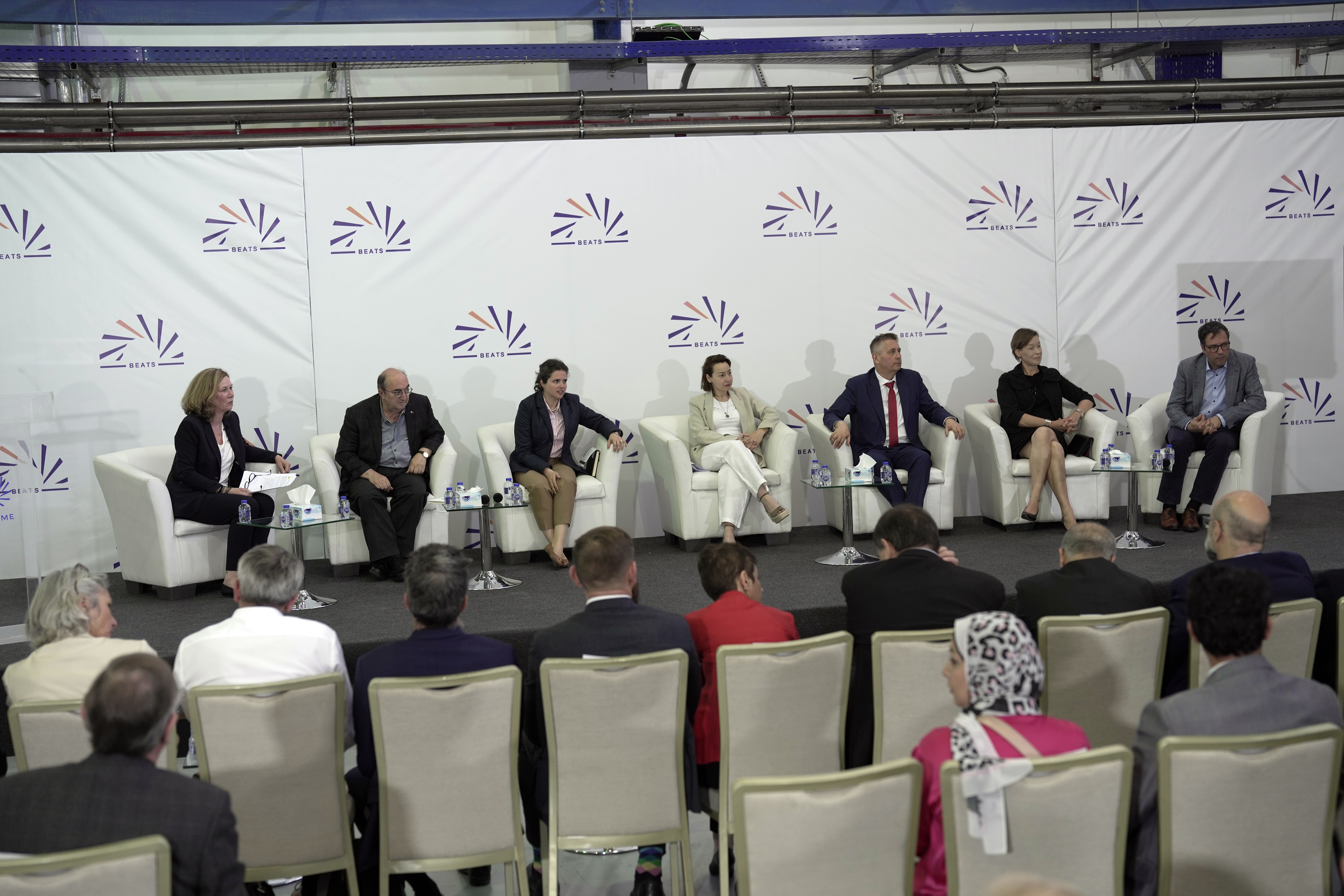
With BEATS, the fifth beamline at the SESAME (Synchrotron-light for Experimental Science and Applications in the Middle East) synchrotron was ceremoniously inaugurated on 6 June 2023. SESAME, operating since 2017, is an intergovernmental laboratory located near Amman (Jordan) and the only synchrotron facility in the Middle East and neighbouring regions.
The new BEATS (BEAmline for Tomography at Sesame) beamline will provide full-field X-ray radiography and tomography techniques, thus considerably extending the scientific possibilities of the Facility and the research opportunities in the region. BEATS first delivered synchrotron light to its experimental station on 11 May 2023, a success that is now being celebrated.
BEATS was designed, built and successfully commissioned thanks to a European project that brought together leading research facilities in the Middle East (SESAME and The Cyprus Institute), and European synchrotron radiation facilities: ALBA-CELLS (Spain), DESY (Germany), Elettra (Italy), the ESRF (France), INFN (Italy), PSI (Switzerland) and SOLARIS (Poland). The initiative has been funded through a 6 million euro grant by the European Union’s Horizon 2020 research and innovation programme under Grant Agreement No. 822535. The project, which started in 2019, was coordinated by the ESRF.
“SESAME brings together researchers from different countries in the Middle East and neighbouring regions. BEATS will facilitate these important regional cooperations and strengthen yet more the knowledge exchange between scientists,” says Rolf-Dieter Heuer, President of the SESAME Council. “The growth of scientific knowledge and expertise in turn contributes to economic development, innovation, and competitiveness of the region as a whole.”
“BEATS adds new analytical capabilities to SESAME’s research portfolio. Tomographic X-ray microscopy will allow the non-destructive investigation of unique samples and will provide a formidable research tool for many scientific areas,” went on to say Khaled Toukan, Director of SESAME.
Two powerful techniques for non-destructive 3D imaging
Indeed, BEATS will offer two kinds of powerful experimental 3D imaging techniques that are new at SESAME: full-field X-ray radiography and tomography. They will be helpful for the analysis of a large variety of objects and materials and thus offer the opportunity to study an impressive range of scientific questions in the areas of medicine, biology, engineering, and materials science, as well as earth and planetary sciences. Thanks to its non-destructive approach, the new beamline is of particular importance for the study of cultural heritage and archaeological samples, thus constituting a key asset for researchers in the SESAME region.
"The European Union is proud to be part of this exciting project. We walk the talk and share European knowhow as well as technology," says Maria Hadjitheodosiou, Ambassador of the EU to Jordan. "We have demonstrated our commitment by allocating more than EUR 26 million to SESAME over the years. For instance, it is thanks to a contribution from the European Union, that SESAME has become the world’s first large accelerator complex to be fully powered by renewable energy… Today’s inauguration of its latest beamline contributes not only contributes to scientific excellence in the Middle East; it also strengthens the partnership between the European Union and the region.”
Jordan's Minister of Higher Education and Scientific Research, Azmi Mahafzah adds that Jordan is proud to be the host country of SESAME: “Since the beginning, the SESAME project received the full support of His Majesty King Abdullah II. We are also very grateful to the European Union for its generous contributions and on-going support to SESAME.”
In parallel with the inauguration of the new beamline, SESAME is organizing the first edition of the “BEATS X-ray tomography lectures & training course” that is being held on its premises on 6 – 7 June. Its objective is to train a group of early users from the region and so enable them to use the new beamline effectively.
The first opportunity for scientists to submit a proposal to use the BEATS beamline will be in September 2023.

NOTES FOR EDITORS:
- SESAME (Synchrotron-light for Experimental Science and Applications in the Middle East) is a 2.5 GeV synchrotron light source that was officially inaugurated on 16 May 2017 by H.M. King Abdullah II. It is the first light source in the Middle East and neighbouring countries, and also the region's first true international centre of excellence. There are some 50 synchrotron light sources in the world, including a few in developing countries.
- SESAME is an Associate of LEAPS (League of European Accelerator-Based Photon Sources). It forms part of the INFN-CHNet network dedicated to cultural heritage of the Italian INFN (Istituto Nazionale di Fisica Nucleare) and it hosts an INFN-CHNet laboratory on its premises.
- The Members of SESAME are currently Cyprus, Egypt, Iran, Israel, Jordan, Pakistan, Palestine and Turkey (others are being sought). Brazil, Canada, China, France, Germany, Greece, Italy, Japan, Kuwait, Portugal, the Russian Federation, Spain, Sweden, Switzerland, the UAE, the UK, and the USA are Observers as are CERN and the European Union. Like CERN, SESAME was set up under the auspices of UNESCO, but is now a completely independent intergovernmental organisation.
- SESAME both:
- Fosters scientific and technological capacities and excellence in the Middle East and neighbouring regions (and helps prevent or reverse the brain drain) by enabling world-class research in subjects ranging from biology and medical sciences through materials science, physics and chemistry to cultural heritage - much focussed on issues of regional importance, e.g. related to the environment, health, and agriculture, and
- Builds scientific links and fosters better understanding and a culture of peace through collaboration between peoples with different creeds and political systems.
- Synchrotron light sources are equipped with beamlines that focus the light on samples that scientists wish to study. Each beamline can support several experiments in series and in parallel. SESAME will be exploited in up to 20 or more experiments operating simultaneously on independent beamlines.
- In the first phase there will be seven beamlines at SESAME. Three, the BM02-IR (Infrared) spectromicroscopy, BM08-XAFS/XRF (X-ray Absorption Fine Structure/X-ray Fluorescence) spectroscopy, and ID09-MS/XPD (Materials Science/X-ray Powder Diffraction) beamlines, which support work in basic materials science, life sciences and environmental science, biochemistry, microanalysis, archaeology, geology, cell biology, biomedical diagnostics, environmental science, etc., are already in operation. The ID11L-HESEB (HElmholtz-SEsame Beamline) beamline for soft X-ray light, which was generously funded by the Helmholtz Association of German Research Centres and designed and constructed by a consortium of five Helmholtz Research Centers under the leadership of DESY (Deutsches Elektronen-Synchrotron), was inaugurated in June 2022. Like the ID10-BEATS (BEAmline for Tomography at SESAME) beamline just inaugurated, it will be hosting its first users in 2023. Construction of the ID11R-TXPES (Turkish soft X-ray PhotoElectron Spectroscopy) beamline, which will share the undulator source of the HESEB beamline and is being funded by the Turkish Government, has started. It is being constructed by Bilkent University, TARLA (Turkish Accelerator and Radiation Laboratory), Koç University and TENMAK (Turkish Energy, Nuclear and Mineral Research Agency ) in a consortium led by TENMAK, and it is the first beamline at SESAME to be designed and built by the national community of one of its Members.
- The users of SESAME are based in universities and research institutes in the region. They visit the laboratory periodically to carry out experiments, where they are exposed to the highest scientific standards. The potential user community, which is growing rapidly and already numbers over 1,300, has been, and is being, fostered by a series of Users' Meetings and by training opportunities (supported by the European Union, the IAEA, the Rutherford Fund (UK), various governments and many of the world's synchrotron laboratories) which are bringing significant benefits to the region.
- In July 2018, SESAME opened its doors to its first users. During the years 2017-2023, it issued six calls for proposals for beam time, and a total of 572 proposals were received. This was principally from scientists of its Members, but also from users in the following countries: Algeria, Belgium, Colombia, France, Germany, India, Italy, Kenya, Malaysia, Malta, Mexico, Morocco, Netherlands, Oman, Qatar, Russian Federation, South Africa, Sweden, the UAE, and the U.K.
- Beam time has been granted for 294 of the proposals received. The experiments carried out so far ranged from topics such as novel materials for energy applications such as batteries and fuel cells; the biological analysis of algae; synchrotron-based infrared investigation of shock features in Martian and Lunar meteorites; the possible use of herbs for treating Alzheimer’s Disease; the study of arsenic in the rice grains and rice farm soils in Iran; and ancient manuscripts from the Quran.
- 68 peer-reviewed publications have already resulted from experiments carried out at SESAME. The average scientific impact factor of the journals in which these papers have been published is 5.4, with 30% of them being in journals having an impact factor greater than 10.
- Users visiting the Facility for their experiments are accommodated at SESAME’s Sergio Fubini Guest House located on its campus that was constructed with funds generously provided by the Government of Italy represented by the Ministry for Education, University and Research through INFN. During periods when it is not needed by SESAME, the Guest House may provide a venue for regional meetings on other topics (such as agriculture, water resources and pollution) in secure and easily accessible surroundings, thus furthering SESAME’s mission as a focal point for regional cooperation
- Since February 2019 when SESAME’s solar power plant was inaugurated, SESAME is the world’s first large accelerator complex to be fully powered by renewable energy, thus making it the world’s first carbon neutral accelerator laboratory. This makes SESAME economically, as well as environmentally sustainable. SESAME has signed the UN’s Climate Neutral Now pledge.
- Some US$118 million have so far been invested in SESAME (including the value of the land and building provided by Jordan and of donated equipment, and all operational costs). Staff costs, provision of power, and other operational costs are provided by the Members’ annual contributions. Capital funding has been provided by the Governments of Jordan, Israel, and Turkey, the Royal Court of Jordan, and by the European Union (through CERN and directly), the IAEA, Germany, Italy and Switzerland, and equipment that became surplus to requirements has been donated by Canada, France, Germany, Italy, Switzerland and the U.K.
- Challenges for the future include: funding for construction of an MX (Macromolecular/protein crystallography), SAXS/WAXS (Small-Angle and Wide-Angle X-ray Scattering) and VUV (Vacuum Ultraviolet) spectroscopy beamline to complete the suite of SESAME’s Phase I beamlines; funding for construction of 100 MeV Linac to replace SESAME’s Microtron, which is a first step towards a full energy injector, and of administrative building.
Further Information
SESAME website: https://www.sesame.org.jo/
Further information on BEATS: https://beats-sesame.eu/
BEATS X-ray tomography lectures and training course at SESAME: https://indico.sesame.org.jo/event/4/
Contact Gianluca Iori (Email)

